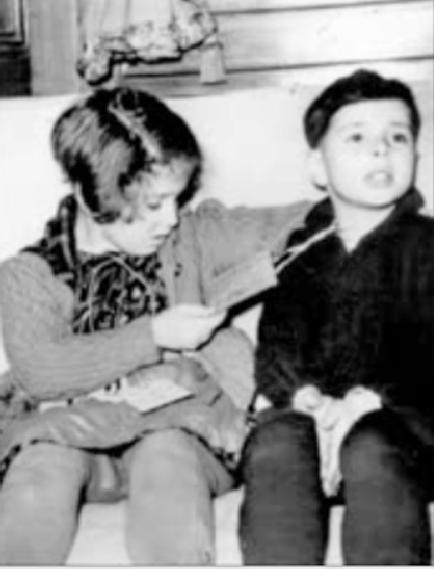
The Kindertransport: Escaping the Reich

Figure 1.--These are two of the Jewish children being transported to England in 1938 as part of the Kindertransport.
They have boarded the train somewhere in the Reich and are on their way to England. The girl is reading the boy's transport number, tied around his neck on a tag. These children look no older than about 9 years old. Notice the typical long stockings, brown and black.
|
|
NAZI authorities made the process of leaving their families and traveling through the Reich needlessly cruel and terrifying. The children had to say a final goodbye to their parents and families for a long train journey to England and numerous harrowing checks by NAZI authorities. Some parents said goodbye to the children at train stations, often away from the general public.
In some cities, parents were not even allowed to say goodbye at the train stations so as to avoid any public spectacle. The trains with the children were sealed. Each child had to wear an identification tag with a transport number which was carefylly checked by the NAZI authorities. The whole experience was traumatic for the children, especially the younger ones, who did not understand why they were being separated from their parents. Some of the older children tried to comfor the yonger children. Often some children were taken off the trains by NAZI officials for various reasons. The trains went from various cities within the Reich and occupied territories to the Netherlands. Apparently NAZI officials decided that they did not want their ports "sullied". Their very limited luggage was virtually torn apart by officials convinced they would find valuables being smuggled out.
The atmosphere changed dramatically when the train crossed the Dutch frobntier. Once the trains reached the Netherlands, the children were greeted with open arms by Dutch women. Often Dutch mothers were waiting for them with hot chocolate and sandwiches. Dutch officials did not believe they could accept any of the children because they had already taken in so many refugees. In the end, this decession saved the lives of many of these children as the Netherlands proved a death trap for Jews after the NAZI invasion (1940). The Dutch Holocaust was once of the worst in Europe. Some of the Kinfertransport groups were also routed through Belgium.
Good Byes
NAZI authorities made the process of leaving their families and traveling through the Reich needlessly cruel and terrifying. The children had to say a final goodbye to their parents and families for a long train journey to England and numerous harrowing checks by NAZI authorities. Some parents said goodbye to the children at train stations, often away from the general public. In some cities, parents were not even allowed to say goodbye at the train stations so as to avoid any public spectacle.
Sealed Train through the Reich
The NAZIs by the time the Kindertransports took place had prohibited Jews from using trains. Thus special permissdion had to be obtained from the NAZI authorities. German Quakers played a major role in making the arrahngements. They helped make the arrangements and many rode with children all the way to the Dutch ports.
The first Kindertransport depasrted from Berlin (December 1, 1938). The first train departed Vienna (December 10). Most of the transports at first came from Berlin and other German cities. More trains from Vienna began (about March 1939). The Germahns invaded Czechoslovakia (March 1939). And as a resuilt there were trains from Prague as well. The cars with the children were sealed. Each child had to wear an identification tag with a transport number which was carefylly checked by the NAZI authorities. The whole experience was traumatic for the children, especially the younger ones, who did not understand why they were being separated from their parents. Some of the older children tried to comfor the yonger children. Often some children were taken off the trains by NAZI officials for various reasons. The trains went from various cities within the Reich and occupied territories to the Netherlands. Their very limited luggage was virtually torn apart by officials convinced they would find valuables being smuggled out.
Poland
A few trains were organized in Poland (February and August 1939). I believed unlike the other trains that they went to Danzig which at the timewas a free city.
The Netherlands
Apparently NAZI officials decided that they did not want their ports "sullied" or blocked with Jewish children so most of the Kindertranports went to the Netherlasnds and the ports there. The atmosphere changed dramatically when the train crossed the Dutch frobntier. Once the trains reached the Netherlands, the children were greeted with open arms by Dutch women. Often Dutch mothers were waiting for them with hot chocolate and sandwiches. Dutch officials did not believe they could accept any of the children because they had already taken in so many refugees. In the end, this decession saved the lives of many of these children as the Netherlands proved a death trap for Jews after the NAZI invasion (1940). The Dutch Holocaust was once of the worst in Europe. The Kindertransports mostly went to the port of the Hook of Holland.
<>br>
Belgium
A few of the Kindertransport groups were also routed through Belgium.
Ferries
From the Dutch and other ports, the children travelled by ferry and liners to thr to the British ports of Harwich or Southampton.
HBC

Navigate the Boys' Historical Clothing Web Site:
[Return to Main Kindertransport page]
[Return to German holocaust page]
[Return to Main Holocaust page]
[Return to Main World War II page]
[Introduction]
[Activities]
[Biographies]
[Chronology]
[Clothing styles]
[Countries]
[Bibliographies]
[Contributions]
[FAQs]
[Glossaries]
[Images]
[Links]
[Registration]
[Tools]
[Boys' Clothing Home]
Created: 4:41 AM 11/27/2008
Last updated: 3:41 AM 7/9/2010



